What Are the Key Benefits of Native Mobile App Development? (With Examples)
What do Slack and WhatsApp have in common?
They are both native mobile apps that changed how people communicate.
These apps have also attracted big-ticket investments. Salesforce acquired Slack for over $27 billion, while Facebook parent firm Meta bought WhatsApp for a cool $19 billion.
These native apps started as ideas in visionaries’ heads. With the right guidance, your mind could be fertile ground for the next groundbreaking native mobile app.
If you’re considering developing native apps for growth and impact, reading this article on the advantages of native mobile app development is a good place to start.
But before we dig deeper, let’s define what native apps are and how they differ from other mobile applications.
What is a native app?
A native app is a program or software created for a specific mobile platform. Each app of this type can only run on one platform, such as Android or iOS.
Imagine you have an idea to combine the best of Amazon and YouTube into one unique native app.
If you want this groundbreaking app to reach Android and iOS users, you must develop two native apps — one app for Android and another for iOS.
Native apps vs. cross-platform apps
Native apps and their cross-platform counterparts generally differ in terms of the number of users reached, performance, cost, and development cycle.
Native apps generally require more man-hours than cross-platform apps. A team of native app developers has to write two sets of code (one for Android and another for iOS) so their app can reach the same number of users as a cross-platform app. Therefore, since native apps are more resource intensive, they usually cost more than cross-platform apps.
On the other hand, cross-platform apps are designed to work across different platforms. Hence, cross-platform development generally costs less than native app development. However, while cross-platform apps offer broader compatibility, they often sacrifice performance and user experience.
Native apps, on the other hand, offer better performance and a superior user experience. This is because native apps are built to work closely with the hardware and software of their host devices. This allows native apps to leverage the full capabilities of mobile phones, something which most cross-platform apps can’t do.
You will see later in the article how app developers and users win because of the close connection between native apps and their host devices.
But for now, here is a recap of how native apps stack up against their cross-platform cousins.
| Native Apps | Cross-platform apps | |
|---|---|---|
| Device compatibility | One platform per app | More than one platform per app |
| User Experience | Better than cross-platform applications | Inferior to native apps |
| Performance | Better than cross-platform applications | Inferior to native apps |
| Cost | More expensive | Cheaper |
It’s easy to dismiss native apps because of their cost and time deficiencies. However, as you will learn later on in this article, the superior quality of native apps means they offer a greater return on investment than cross-platform apps.
There is also a way to manage native app development costs, as you will see in the final section of this blog.
Native app development
For years now, Android and iOS have been the most popular mobile operating systems in the world. Therefore, focusing on native app development for these systems is appropriate since Android and iOS represent a large chunk of the global market.
Native app development for Android
Whether you wing it or hire a developer, many programming languages are available to help you build apps for the Android platform. You can choose between Java and Kotlin.
Google, Android’s developer, has mentioned that Kotlin is its preferred language. Our native app developers have also used Kotlin to successfully develop apps that help people grow their businesses or address social issues. Consult us for free to learn how our Kotlin experts can help make your app vision a resounding success.
On the hardware side, you can use a Mac, Windows PC, or Linux computer to run the aforementioned programming languages.
Native app development for iOS
Developing native applications for the iPhone operating system (iOS) is slightly more complicated than for Android.
For one, the programming languages used for iOS development are undergoing a transition of sorts. Objective-C has been the most popular programming language for iOS devices since the 1980s. However, since Apple launched Swift in 2014, it has increasingly gained popularity in the developer community, making the demise of Objective-C almost certain.
Even our app developers agree that Swift is the future. That’s why we at Appetiser use this leading-edge programming language for iOS native mobile app development.
Additionally, creating iOS apps entails some hardware restrictions that Android development doesn’t suffer from. This is because developers need to use Mac computers to develop and test iOS native mobile apps.
Benefits of native mobile app development
Our product strategy experts and developers have observed that developing native apps has the following advantages:
- Better app user experience
- Superior security
- Fewer app bugs
- Flexibility to add more app features
- Higher app store ranking
Let’s dig deeper into each.
Better app user experience
App users can be highly discriminating — they almost immediately delete any app that shows any sign of poor build quality.
Statistics also show that poor user experience (UX) is a leading cause of app deletions.
Conversely, a superior UX increases app user loyalty, decreasing app uninstalls. User loyalty or retention has an impact on app-based earnings. The more loyal users are to an app, the higher the app’s potential income.
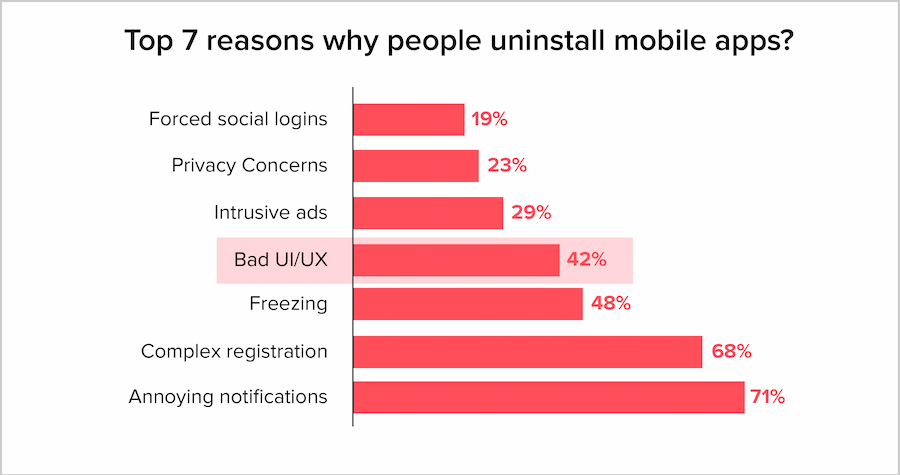
Source: MobileAppDaily.com
This is why native app development is a gem. Native apps tend to have amazing characteristics that keep users coming back for more. These include:
- Consistent look and feel
- Faster loading speed
- Superior performance
These positive characteristics mostly stem from the close compatibility between the native app developers’ software development kits (SDKs) and their host operating systems .
For example, native apps built for Android are built using SDKs that work best with the Android operating system. On the other hand, iOS native apps are created using SDKs most suitable for iPhone operating systems.
Superior security
Would you use an app that can’t protect your personal information?
If you said no, most app users would agree with you.
An IBM study indicates that data breaches cost organizations around $4 million annually.
That’s why many app businesses dealing with sensitive client data opt for native app development. Native mobile apps can more easily access platform-specific security features. Developers can easily implement data protection mechanisms like encryption or fraud detection through these features.
If you’re planning to develop apps for industries like e-commerce, financial losses due to data breaches is something you should account for. After all, user credit card details are open to breaches whenever online purchase transactions occur.
Fewer app bugs
Most people don’t like apps that frequently crash or don’t function as they should.
One of the reasons why apps suffer bugs like these is they have difficulty keeping up with platform updates. For example, if Android or iOS gets updated, apps can either react well or negatively to the new platform update.
Native app developers have easy access to new software development kits released by Android or iOS developers. These SDK updates usually go hand-in-hand with platform updates.
As such, native app developers can build applications that are up-to-date with the latest Android or iOS versions. This minimizes the instance of bugs developing in native applications.
Another way to minimize bugs is hiring the right app developers, like what Grill’d did. The Australian restaurant giant approached us at Appetiser with a crash-prone app. Check out our case study to learn how we turned the app into a 99.9% bug-free application that reeled in more customers.
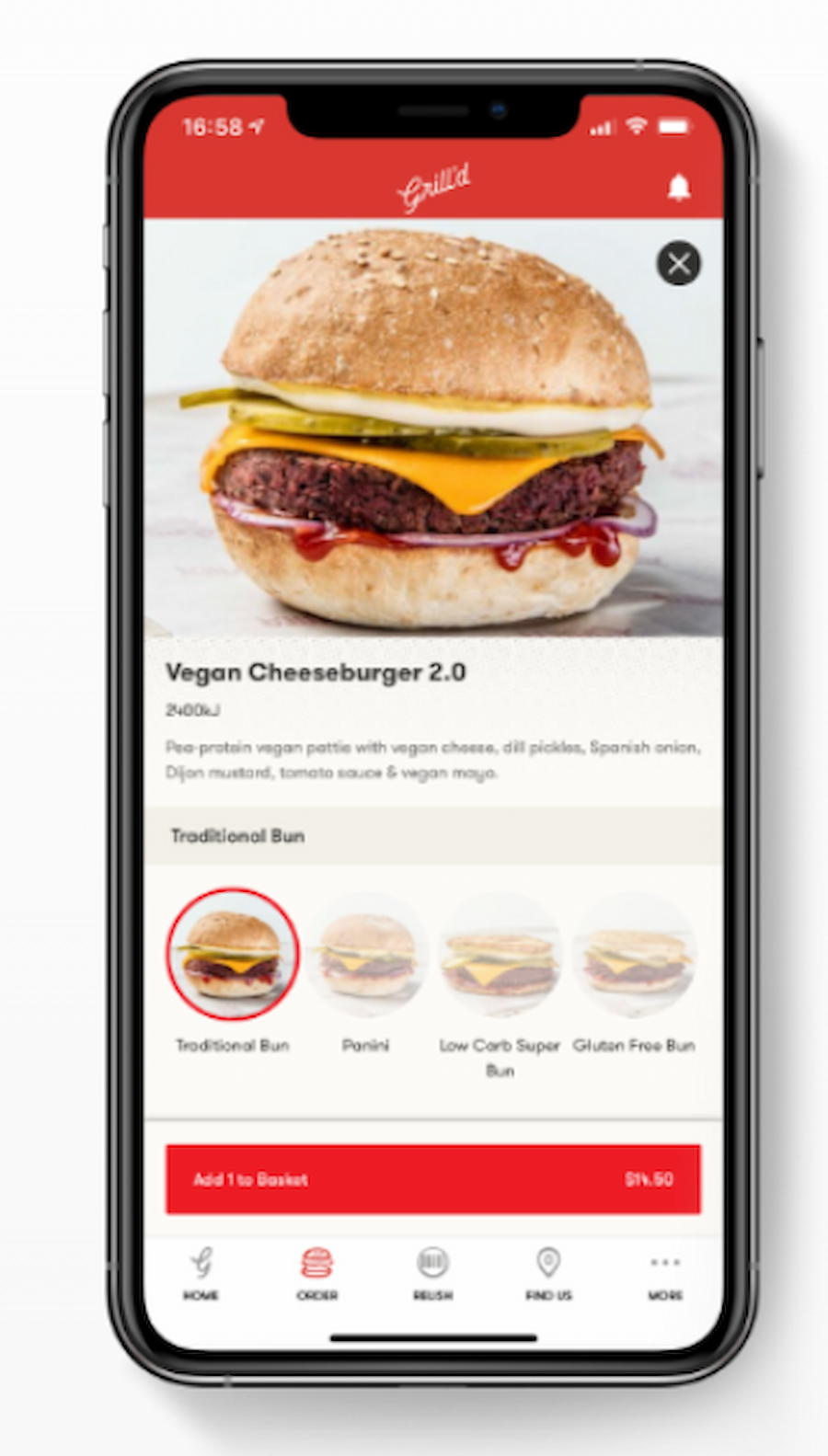
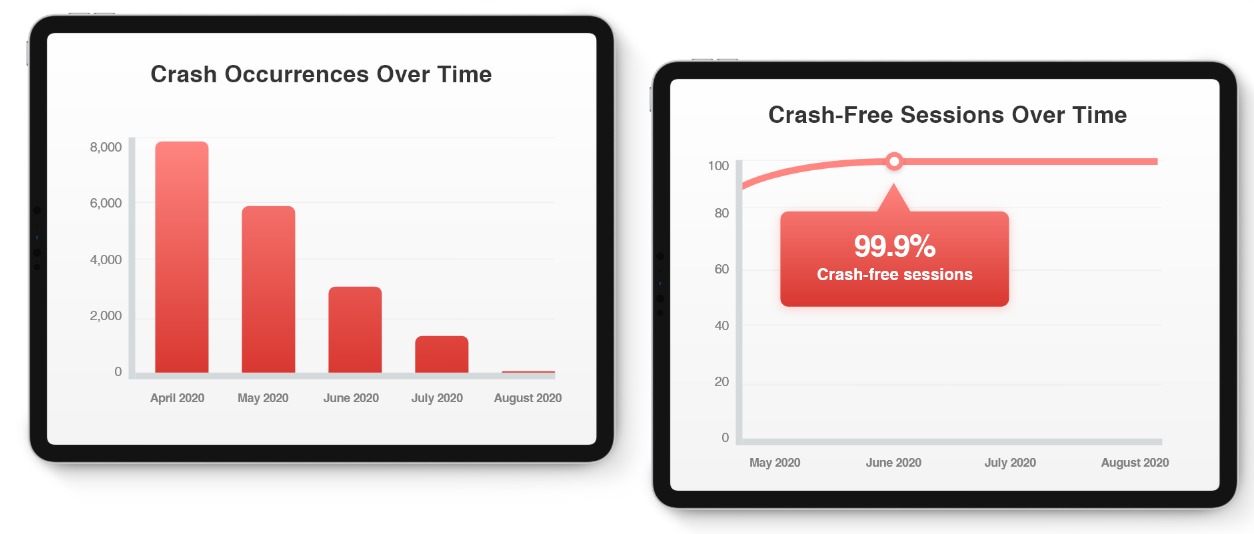
Flexibility to add more app features
Few entrepreneurs wouldn’t want to have that extra piece of land on which to expand their business.
The flexibility to add new app features is like that extra plot of real estate.
Many apps are actually businesses. And like many sustainable businesses, the most excellent apps start small but have the capability to scale when they gain market traction. Scalable applications enable app businesses to expand exponentially without wasting too much money.
Our product strategists have led many clients to success by developing apps with basic features, at least initially. Then, more features are added as the apps gain more users in the market. This gradual iteration is called the MVP way of developing apps and has been proven to keep project costs manageable.
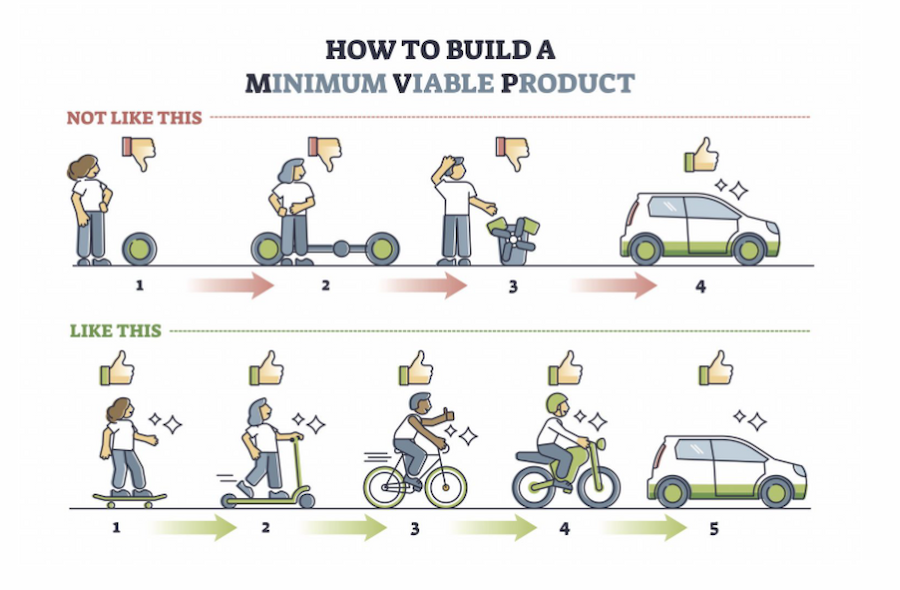
Source: Inflectiv.co
Native mobile app development is best suited to the MVP (Minimum Viable Product) method’s gradual addition of new features.
Since native apps are developed for specific platforms, they tend to have access to a wider variety of hardware and software features available to their devices. A native app can take advantage of its host phone’s GPS, camera, microphone, etc. The more phone resources that the native app has access to, the more the app can expand to include more features.
Suppose you’re developing a mobile app that enables users to relay their current location with a single tap. After your app gained market traction, your users requested a video recording feature to be added.
Native app development can make this addition possible since the app you developed can access your phone’s GPS feature AND its camera.
The hypothetical example I gave above has a real-world equivalent. Our Geavi app enables users to record video evidence of any crime or incident with just a few screen taps. Aside from video, the app also archives the location where an incident happened.
The Geavi app success story is not one to miss if you’re interested in native apps that enhance public safety.
Higher app store ranking
When you run a Google search, which results do you often look at?
Chances are, you would have likely clicked the first few results The same principle applies in app downloads.
When users look for apps in the app stores, they also tend to download those at the top of the search results.
One of the key principles of app store optimization is that apps with positive user ratings usually occupy the top spots of app store search results. Since native apps tend to have superior performance, they are more likely to be given favorable feedback. Hence, they tend to rank higher in app stores.
Now you’ve seen what makes native mobile app development awesome, it’s time to discover some famous products of this method of application development.
Shining examples of native mobile app development
The following brilliant apps are among the world’s best fruits of native app development:
MyDeal: A better deal for both founder and online buyers
MyDeal has been an e-commerce giant in Australia since 2010. But founder Sean Senvirtne found out a few years after setting up the company that online purchases via smartphones are starting to catch fire. He realized his e-commerce website would not be enough to catch up to competitors who have mobile apps.
That’s why Sean approached Appetiser for a customized mobile app. With the help of our app developers and product strategists, MyDeal’s native mobile app was able to reach more customers and attract multimillion-dollar funding. To learn more, check out our case study on our native app development project for MyDeal.
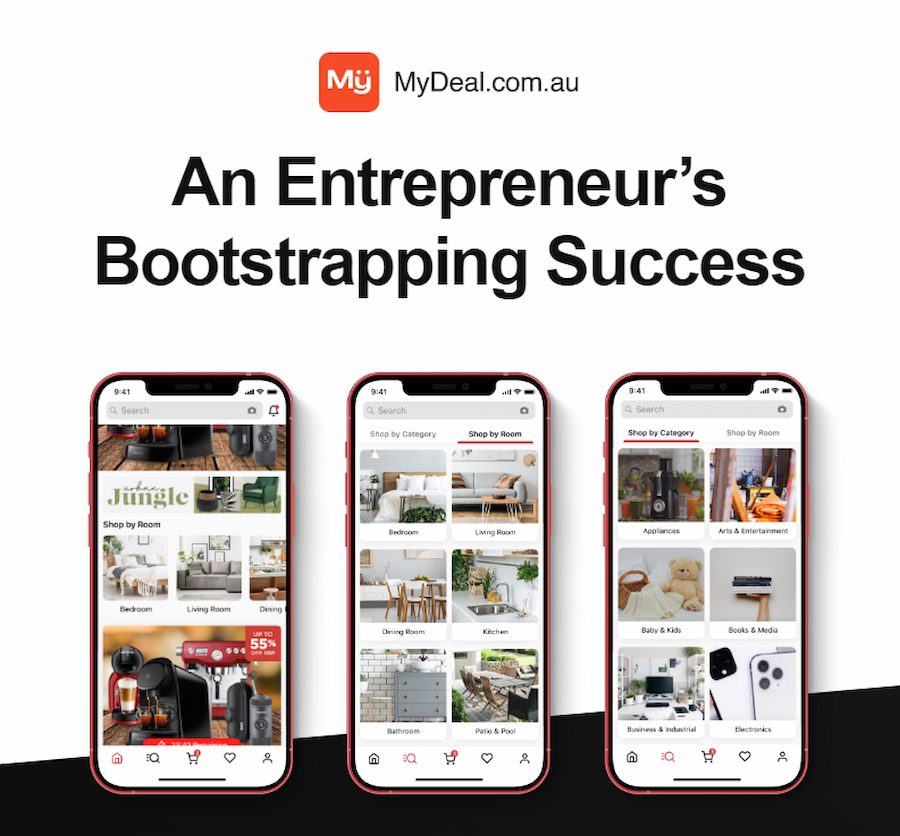
Slack: Helping workers “pick up the slack”
Many businesses and remote teams use this messaging application. Its users have mentioned that the app integrates better with office tools than its rivals.
Slack’s native app for Android is developed using Java and Kotlin, while the app’s iOS counterpart is based on the Swift and Objective-C programming languages.
Spotify: Music (and more) to your ears
Many listeners have mentioned that this app is not your average music streaming service.
Spotify mobile apps give users access to podcasts and audiobooks, something that similar services in the past did not offer. The Spotify app can also integrate well with digital assistants like Alexa and Google Assistant. This means playing songs could be as easy as saying “Uptown Funk” or “Moonlight Sonata.”
Java is one of the many programming languages used to build the Spotify native app for Android.
Telegram: Sending coded messages
The Telegram app prides itself in encrypting some of its messages and calls. Encryption minimizes the risk of unwarranted personal information exposure from in-app communications.
Java, Objective-C, and Swift are among the programming languages used to develop Telegram for Android and iOS, respectively.
A natural at native app development
Native app development ticks all the right boxes when it comes to providing the best and safest experience for mobile app users.
I did mention that native app development is more costly than, say, developing cross-platform and hybrid apps.
But there’s always an exception. Look at our Appetiser team.
Our native app developers use the most cutting-edge and future-proof tools to come up with high-quality apps for businesses and nonprofits. Appetiser’s product strategy experts also bring apps to market 50% faster than average, lessening app development costs.
Book a free consultation with us to learn how our native app development expertise can turn your vision into a financially-viable and world-changing reality.

Jesus Carmelo Arguelles, aka Mel, is a Content Marketing Specialist by profession. Though he holds a bachelor’s degree in business administration, he also took courses in fields like computer troubleshooting and data analytics. He also has a wealth of experience in content writing, marketing, education, and customer support.



